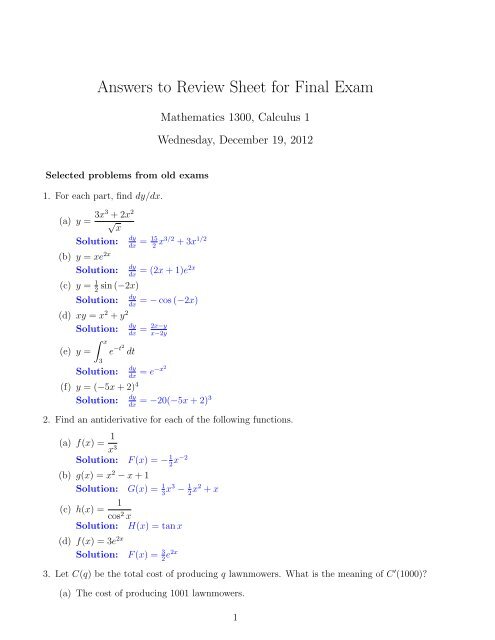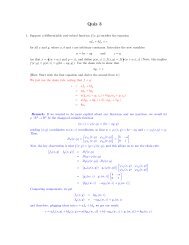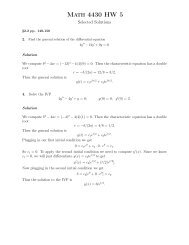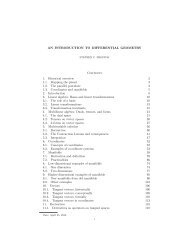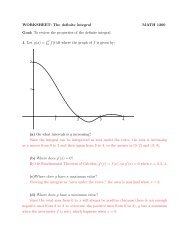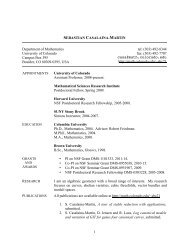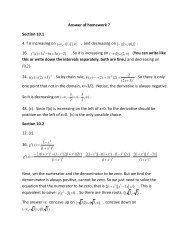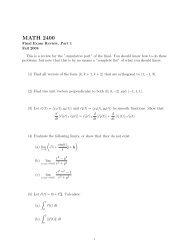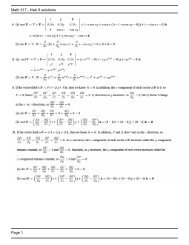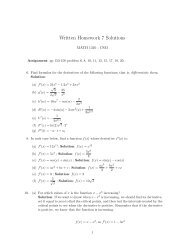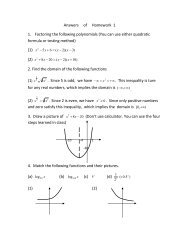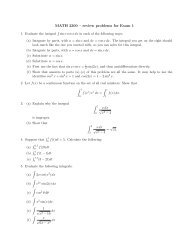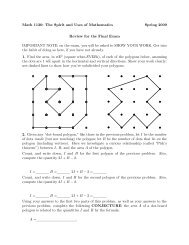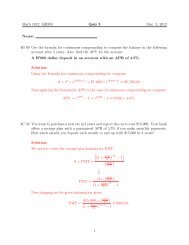Answers to Review Sheet for Final Exam
Answers to Review Sheet for Final Exam
Answers to Review Sheet for Final Exam
Create successful ePaper yourself
Turn your PDF publications into a flip-book with our unique Google optimized e-Paper software.
<strong>Answers</strong> <strong>to</strong> <strong>Review</strong> <strong>Sheet</strong> <strong>for</strong> <strong>Final</strong> <strong>Exam</strong><br />
Selected problems from old exams<br />
1. For each part, find dy/dx.<br />
(a) y = 3x3 + 2x 2<br />
√ x<br />
Solution:<br />
(b) y = xe 2x<br />
Solution:<br />
(c) y = 1<br />
2<br />
Solution:<br />
dy<br />
dx<br />
dy<br />
dx<br />
sin (−2x)<br />
(d) xy = x 2 + y 2<br />
(e) y =<br />
Solution:<br />
x<br />
3<br />
Solution:<br />
dy<br />
dx<br />
dy<br />
dx<br />
e −t2<br />
dt<br />
dy<br />
dx<br />
(f) y = (−5x + 2) 4<br />
Solution:<br />
dy<br />
dx<br />
Mathematics 1300, Calculus 1<br />
Wednesday, December 19, 2012<br />
= 15<br />
2 x3/2 + 3x 1/2<br />
= (2x + 1)e2x<br />
= − cos (−2x)<br />
= 2x−y<br />
x−2y<br />
= e−x2<br />
= −20(−5x + 2)3<br />
2. Find an antiderivative <strong>for</strong> each of the following functions.<br />
(a) f(x) = 1<br />
x3 Solution: F (x) = − 1<br />
2x−2 (b) g(x) = x2 − x + 1<br />
Solution: G(x) = 1<br />
3x3 − 1<br />
2x2 + x<br />
(c) h(x) = 1<br />
cos2 x<br />
Solution: H(x) = tan x<br />
(d) f(x) = 3e 2x<br />
Solution: F (x) = 3<br />
2 e2x<br />
3. Let C(q) be the <strong>to</strong>tal cost of producing q lawnmowers. What is the meaning of C ′ (1000)?<br />
(a) The cost of producing 1001 lawnmowers.<br />
1
(b) The average cost of producing each of the first 1000 lawnmowers.<br />
(c) The approximate cost of producing the 1001 st lawnmower.<br />
(d) None of the above.<br />
Solution: C ′ (1000) ≈ C(1001) − C(1000), so it represents the additional cost <strong>to</strong> produce<br />
one more lawnmower when 1000 are already being produced. The answer is (c).<br />
4. What are the inflection points of f(x) = x 5 − 5x 4 − 50?<br />
Solution: x = 3 is the only inflection point.<br />
5. Solve the differential equation dq<br />
= 2 + sin(z) with initial condition q(π) = 2π.<br />
dz<br />
Solution: q(z) = 2z − cos z − 1<br />
6. Using the left-hand Riemann sum with n = 4, approximate<br />
Solution: 9<br />
7. Suppose that f is a continuous function with<br />
What is<br />
6<br />
4<br />
f(x) dx?<br />
6<br />
Solution: 6<br />
f(x) dx =<br />
4<br />
0<br />
1<br />
9<br />
1<br />
1<br />
x dx.<br />
<br />
1 1 1 1 1<br />
dx ≈ 2 · + + + =<br />
x 1 3 5 7<br />
352<br />
105 .<br />
f(x) dx = −10 and<br />
6<br />
0<br />
f(x) dx −<br />
4<br />
8. Find the average value of f(x) = 1<br />
over [1, e].<br />
x<br />
Solution:<br />
e<br />
f(x) dx<br />
1 Average(f) =<br />
e − 1<br />
9. Suppose that f is given <strong>for</strong> x in the interval [0, 12] by<br />
Estimate f ′ (2).<br />
Solution: f ′ (2) ≈<br />
0<br />
4<br />
0<br />
f(x) dx = 3.<br />
f(x) dx = −10 − 3 = −13.<br />
= ln e − ln 1<br />
e − 1<br />
= 1<br />
e − 1 .<br />
x 0 2 4 6 8 10 12<br />
f(x) −19 −21 −25 −28 −29 −28 −25<br />
f(4) − f(0)<br />
4 − 0<br />
= −25 + 19<br />
4<br />
2<br />
= −1.5.
10. If H(3) = 1, H ′ (3) = 3, F (3) = 5, F ′ (3) = 4, find G ′ (3) if G(w) = F (w)/H(w).<br />
Solution: G ′ (3) = H(3)F ′ (3) − F (3)H ′ (3)<br />
H(3) 2<br />
= 1 · 4 − 5 · 3<br />
1 2<br />
= −11.<br />
11. Suppose f(x) is continuous on [−1, 1] and differentiable on (−1, 1). Which of the following is<br />
true?<br />
(a) If f(x) has a critical point at x = 0 and f ′′ (x) < 0, then f(x) has a local minimum at<br />
x = 0.<br />
(b) If f(x) has a critical point at x = 0 and f ′′ (x) > 0, then f(x) has a local minimum at<br />
x = 0.<br />
(c) If f(x) has a critical point at x = 0, then f(x) has a local minimum or maximum at<br />
x = 0.<br />
(d) If f(x) has a critical point at x = 0 and f ′′ (0) = 0, then x = 0 is an inflection point.<br />
Solution: Only (b) is true, by the Second Derivative Test. (c) is false by considering f(x) =<br />
x 3 , and (d) is false by considering f(x) = x 4 .<br />
12. Suppose F ′ (x) = −3 cos x and F (0) = 2. Find F ( 3π<br />
2 ).<br />
Solution: F ( 3π<br />
) = F (0) +<br />
2 0<br />
13. Compute d<br />
2<br />
3 sin (t<br />
dx x<br />
2 <br />
) dt .<br />
Solution: −3 sin (x2 )<br />
3π/2<br />
F ′ (x) dx = 2 − 3<br />
3π/2<br />
0<br />
cos x dx = 2 − 3 sin (3π/2) = 5.<br />
14. What is the largest area a rectangle with a perimeter of 40 inches can have?<br />
Solution: Set up 2x + 2y = 40 and A = xy <strong>to</strong> get A = x(20 − x). This is maximized when<br />
x = 10, so the maximum area is A = 100 square inches.<br />
15. A rocket’s height (in feet) is given by s(t) = 3e 2t + 10, where t is in seconds. How fast is the<br />
rocket traveling when it reaches a height of 40 feet?<br />
Solution: It reaches 40 feet when t = 1<br />
2 ln 10, and at this time s′ (t) = 6e 2t = 60 feet per<br />
second.<br />
16. A circular oil spill is growing. Its radius is increasing at a rate of 10 feet per minute. When<br />
the radius is 2500 feet, at what rate is the area of the oil spill growing?<br />
Solution: dA<br />
dt<br />
= 2πr dr<br />
dt<br />
= 50, 000π square feet per minute.<br />
17. Let a be a positive constant. Find and classify the critical points of f(x) = x 2 (a − x) as local<br />
maxima, local minima, or neither.<br />
Solution: The critical points are x = 0 and x = 2a<br />
minimum. Since f ′′ ( 2a<br />
3<br />
18. Suppose that F (x) =<br />
) = −2a < 0, x = 2a<br />
3<br />
x<br />
1<br />
3 . Since f ′′ (0) = 2a > 0, x = 0 is a local<br />
is a local maximum.<br />
ln t dt <strong>for</strong> x > 0. Which of the following statements is false?<br />
3
(a) F (1) = 0.<br />
(b) F ′ (e) = 1.<br />
(c) F (x) is increasing at x = 2.<br />
(d) F (x) is increasing at x = 1<br />
2 .<br />
Solution: F ′ (x) = ln x, and we have F ′ ( 1)<br />
= − ln 2 < 0. So (d) is false.<br />
2<br />
19. Assume f ′ is given by the graph below.<br />
a) Find the value of the integral: 7<br />
0 f ′ (x) dx<br />
7<br />
Solution: 0 f ′ (x) dx = 2−1+3−3+3−<br />
2 + 2 = 4.<br />
b) What can you say about the second derivative<br />
of f, i.e., about f ′′ ?<br />
Solution: It is zero everywhere it exists,<br />
and it does not exist at any of the integers.<br />
c) Suppose f is continuous and that f(0) = 1.<br />
Sketch an accurate graph of f in the above<br />
box (which already contains a graph of f ′ ).<br />
Solution: It’s piecewise linear, so we just<br />
need <strong>to</strong> fill it in at the integers and then<br />
connect the dots.<br />
20. Represent the finite area enclosed by the two curves y = x 2 and y = √ x as an integral.<br />
Solution: The curves cross at x = 0 and x = 1, and y = √ x is on <strong>to</strong>p, so the area is<br />
A =<br />
1<br />
0<br />
√ x − x 2 dx = 1<br />
3 .<br />
21. You have 80 feet of fencing and want <strong>to</strong> enclose a rectangular area up against a long, straight<br />
wall (using the wall <strong>for</strong> one side of the enclosure and the fencing <strong>for</strong> the other three sides of<br />
the enclosure). What is the largest area you can enclose?<br />
Solution: Use 2x+y = 80 and A = xy <strong>to</strong> get A = x(80−2x) which is maximized at x = 20,<br />
so the maximum area is 800 square feet.<br />
x + 1<br />
22. Find the global maximum and minimum <strong>for</strong> h(x) =<br />
x2 on the interval −1 ≤ x ≤ 2.<br />
+ 3<br />
Solution: Critical points occur at x = 1 and x = −3; only x = 1 is relevant since it’s in the<br />
interval. Test h(−1) = 0, h(1) = 1<br />
3<br />
, and h(2) = <strong>to</strong> find the global minimum at x = −1 and<br />
2 8<br />
the global maximum at x = 1.<br />
23. Fill in each of the blanks below with the best possible answer.<br />
4
a) If f is continuous on a ≤ x ≤ b and differentiable on a < x < b, then there exists a number<br />
c, with a < c < b, such that<br />
f ′ f(b) − f(a)<br />
(c) = .<br />
b − a<br />
b) For any function f, the function whose value at x is given by<br />
lim<br />
h→0<br />
is called f ′ (x), or the derivative of f.<br />
24. Evaluate each of the following limits.<br />
2<br />
a) lim<br />
x→0<br />
−x − x<br />
x2 + 9<br />
Solution: Plug in x = 0 <strong>to</strong> get 1/9.<br />
f(x + h) − f(x)<br />
,<br />
h<br />
3x<br />
b) lim<br />
x→∞<br />
2 − x4 − 5x5 x5 − 1<br />
Solution: Compare the highest terms −5x5 /x5 <strong>to</strong> get −5.<br />
c) lim<br />
x→0− |x − 1|<br />
x − 1<br />
Solution: Plug in x = 0 <strong>to</strong> get −1.<br />
25. Find the equation of the tangent line <strong>to</strong> the curve y = √ 25 − x 2 where x = 3.<br />
Solution: y − 4 = − 3(x<br />
− 3).<br />
4<br />
26. Let f(x) be the function whose graph is given below. Define<br />
F (x) =<br />
x<br />
0<br />
f(t)dt.<br />
Use the graph <strong>to</strong> fill in the entries in the table below:<br />
x 2 3<br />
F (x) 2 1.5<br />
F ′ (x) 0 −1<br />
F ′′ (x) −1 DNE<br />
27. A 10-meter ladder is leaning against the wall of a building with its base 2 meters from the<br />
wall. The base of the ladder begins sliding away from the building at a rate of 3 meters per<br />
second. How fast is the <strong>to</strong>p of the ladder sliding down the wall when the base of the ladder<br />
is 6 meters from the wall?<br />
Solution: Differentiate x 2 + y 2 = 10 2 with respect <strong>to</strong> time <strong>to</strong> get x dx<br />
dt<br />
x = 6, y = 8. Plug in x = 6 and dx<br />
dt<br />
= 3 and y = 8 <strong>to</strong> get dy<br />
dt<br />
5<br />
= − 9<br />
4<br />
= 0. When<br />
meters per second.<br />
+ y dy<br />
dt
28. If f(x) is a function having all four of the following properties:<br />
1<br />
0<br />
f ′ (x) dx = 2,<br />
then determine the following:<br />
(a)<br />
29. Let<br />
3<br />
0<br />
f ′ (x) dx<br />
Solution:<br />
(b) f(0).<br />
3<br />
0<br />
f ′ (x) dx =<br />
Solution: f(3) − f(0) =<br />
2<br />
(a) Find F ′ (x).<br />
Solution: F ′ (x) = 2xe −4x4<br />
1<br />
1<br />
0<br />
3<br />
0<br />
f ′ (x) dx = 4,<br />
f ′ (x) dx +<br />
2<br />
1<br />
3<br />
2<br />
f ′ (x) dx = 8, f(3) = 16,<br />
f ′ (x) dx +<br />
3<br />
2<br />
f ′ (x) dx = 2 + 4 + 8 = 14.<br />
f ′ (x) dx = 14. So 16 − f(0) = 14, and f(0) = 2.<br />
F (x) =<br />
(b) Find F ′′ (x).<br />
Solution: F ′′ (x) = 2e −4x4<br />
− 32x 4 e −4x4<br />
x 2<br />
0<br />
e −4t2<br />
dt.<br />
(c) Find the x coordinates of all inflection points of F (x).<br />
Solution: F ′′ (x) = 0 when 2 = 32x4 or x4 = 1<br />
1<br />
, so x = ± . These are both genuine<br />
16 2<br />
inflection points since F ′′ changes sign: F ′′ (−1) < 0, F ′′ (0) > 0, and F ′′ (1) < 0.<br />
30. Find the area between the graphs of f(x) = x + 6 and g(x) = x 2 .<br />
Solution: The graphs cross when x + 6 = x2 , i.e., x = 3 and x = −2. The line is above the<br />
parabola in this region, so the area is<br />
3<br />
A = (x + 6 − x 2 <br />
1<br />
) dx =<br />
2 x2 + 6x − 1<br />
3 x3<br />
x=3<br />
=<br />
x=−2<br />
27<br />
2 −<br />
<br />
− 22<br />
<br />
=<br />
3<br />
125<br />
6 .<br />
−2<br />
31. Use the definition of the derivative (as a limit of a difference quotient) <strong>to</strong> find the derivative<br />
of<br />
f(x) = x 2 − 1.<br />
Note: you may use shortcuts (derivative <strong>for</strong>mulas) <strong>to</strong> check your solution. However, <strong>to</strong> get<br />
full credit <strong>for</strong> this problem you need <strong>to</strong> use the definition of the derivative <strong>to</strong> find f ′ (x).<br />
6
Solution:<br />
32. Solve the initial value problem<br />
f ′ f(x + h) − f(x)<br />
(x) = lim<br />
h→0<br />
<br />
h<br />
<br />
2 2 (x + h) − 1 − x − 1<br />
= lim<br />
h→0<br />
h<br />
x<br />
= lim<br />
h→0<br />
2 + 2xh + h2 − 1 − x2 + 1<br />
h<br />
2xh + h<br />
= lim<br />
h→0<br />
2<br />
h<br />
= lim(2x<br />
+ h)<br />
h→0<br />
= 2x.<br />
dy<br />
dx<br />
Solution: y(x) = x + sin x + π.<br />
= 1 + cos x, y(π) = 2π.<br />
33. Sketch the graph of a continuous, differentiable function f, whose domain is 0 < x < ∞, given<br />
the following in<strong>for</strong>mation about f, f ′ , and f ′′ :<br />
Solution:<br />
f(1) = 0,<br />
lim f(x) = −∞,<br />
x→0 +<br />
f(x) < 0 <strong>for</strong> x < 1, f(x) > 0 <strong>for</strong> x > 1,<br />
f ′ (2) = 0, f ′ (x) > 0 <strong>for</strong> x < 2, f ′ (x) < 0 <strong>for</strong> x > 2,<br />
f ′′ (3) = 0, f ′′ (x) < 0 <strong>for</strong> x < 3, f ′′ (x) > 0 <strong>for</strong> x > 3,<br />
lim f(x) = 0.<br />
x→+∞<br />
7
34. Assuming that f(1) = 9 and f ′ (1) = 4, find<br />
(a) g ′ (1), where g(x) = f(x).<br />
Solution: g ′ (1) = 1<br />
2 f(1)−1/2 f ′ (1) = 2<br />
3 .<br />
(b) h ′ (1), where h(x) = f( √ x).<br />
Solution: h ′ (1) = f ′ ( √ 1) · 1<br />
2 1−1/2 = 2.<br />
35. Let f(x) = 1<br />
.<br />
1 + x2 (a) Find the local linearization of f near x = 1.<br />
Solution: f(1) = 1<br />
2 and f ′ (1) = − 1<br />
2<br />
(b) Use the local linearization you found <strong>to</strong> estimate f(1.1).<br />
Solution: f(1.1) ≈ L(1.1) = 0.45.<br />
36. Let C be the curve defined by the equation xy + y 2 = 4.<br />
(a) Verify that the point (3, 1) lies on the curve C.<br />
Solution: 3 · 1 + 1 2 = 4.<br />
, so the local linearization is L(x) = 1<br />
2<br />
1 − (x − 1).<br />
2<br />
(b) Find an equation <strong>for</strong> the tangent line <strong>to</strong> C at the point (3, 1).<br />
dy y<br />
1<br />
Solution: = − , so at (3, 1) the slope is m = − . The tangent line is<br />
5 dx x + 2y<br />
y − 1 = − 1(x<br />
− 3).<br />
5<br />
37. Consider the following function f.<br />
(a) Find an approximation <strong>to</strong> the area under the<br />
graph of f, from x = 0 <strong>to</strong> x = 4, using a left<br />
endpoint Riemann sum with four rectangles.<br />
Solution:<br />
5) = 46.<br />
4<br />
0<br />
f(x) dx ≈ 1 · (20 + 13 + 8 +<br />
(b) Is your answer an overestimate of the actual<br />
area under the graph, or is it an underestimate?<br />
Please explain your reasoning.<br />
Solution: It is an overestimate. Every<br />
one of the rectangles we used has larger area<br />
than is actually under the curve. (For decreasing<br />
functions, left sums always overestimate.<br />
12. Consider the following function f.<br />
(0,20)<br />
y=f(x)<br />
(1,13)<br />
(2,8)<br />
(3,5)<br />
1 2 3 4<br />
(4,4)<br />
(a) Find an approximation <strong>to</strong> the area under the graph of f, from x = 0 <strong>to</strong> x = 4,<br />
using a left endpoint Riemann sum with four rectangles.<br />
38. Suppose that f is a differentiable and invertible function, with values given in the table below.<br />
x 0 1 2 3 4 5 6 7 8 9<br />
f(x) −7 −5 −4 −2 0 4 6 7 8 20<br />
f ′ (x) 1 2 1 3 4 4 2 1 4 6<br />
8<br />
(b) Is your answer an overestimate of the actual area under the graph, or is it an<br />
underestimate? Please explain your reasoning.
(a) Evaluate f −1 (4).<br />
Solution: f −1 (4) = 5.<br />
(b) Evaluate d<br />
dx f −1 (x) at x = 4.<br />
Solution: (f −1 ) ′ (4) =<br />
1<br />
f ′ (f −1 (4))<br />
= 1<br />
f ′ (5)<br />
= 1<br />
4 .<br />
(c) Find the equation of the line tangent <strong>to</strong> the graph of f −1 (x) at the point x = 4.<br />
Solution: y − 5 = 1(x<br />
− 4)<br />
4<br />
39. The motion of a certain particle moving in the xy-plane can be modeled by the following<br />
parametric equations:<br />
x = cos (3t) y = sin (3t).<br />
(a) Determine dy<br />
when t = π/12.<br />
dx<br />
dy dy/dt 3 cos 3t<br />
Solution: = = , so when t = π/12 we have dy/dx = −1.<br />
dx dx/dt −3 sin 3t<br />
(b) What’s the smallest positive value of t at which the particle is traveling straight down?<br />
Solution: It travels straight down when dx<br />
dy<br />
dx<br />
= 0 and < 0. We know = 0 when<br />
dt dt dt<br />
sin 3t = 0, or when t = π 2π<br />
π<br />
dy<br />
, , . . .. When t = , we compute = 3 cos π = −3, so the<br />
3 3 3 dt<br />
particle is traveling straight down.<br />
(c) What’s the smallest positive value of t at which the particle is traveling straight <strong>to</strong> the<br />
right?<br />
Solution: The particle travels <strong>to</strong> the right when dy<br />
dx<br />
dy<br />
= 0 and > 0. We know = 0<br />
dt dt dt<br />
when cos 3t = 0, i.e., when t = π π 5π<br />
π<br />
dx<br />
π<br />
, , , . . .. When t = we have = −3 sin < 0, so<br />
6 2 6 6 dt 2<br />
the particle is moving left. When t = π<br />
dx<br />
3π<br />
we have = −3 sin > 0, so the particle is<br />
2 dt 2<br />
moving <strong>to</strong> the right.<br />
(d) Circle the correct choice and please explain your answer: the path traced out by the<br />
particle in the xy plane, over the interval 0 ≤ t ≤ π/3, is:<br />
(i) a parabola (ii) a circle (iii) a line segment<br />
(iv) an ellipse (v) a semicircle<br />
Solution: Since x 2 + y 2 = 1, we know the particle is on a circle. From 0 <strong>to</strong> π/6 <strong>to</strong> π/3,<br />
the particle goes from (1, 0) <strong>to</strong> (0, 1) <strong>to</strong> (−1, 0). So it traverses the <strong>to</strong>p half of a circle<br />
counterclockwise. Hence the answer is (v).<br />
40. Evaluate the following derivatives. Show your work, but you need not simplify.<br />
(a) d<br />
dx [πe + 2]<br />
Solution: 0. It’s just the derivative of some complicated constant.<br />
(b) d x 3<br />
3 + x<br />
dx<br />
<br />
Solution: 3 x ln 3 + 3x 2<br />
(c) d<br />
[arctan(t) ln(t/5)]<br />
dt<br />
ln (t/5) arctan t<br />
Solution: +<br />
1 + t2 t<br />
9
(d) d<br />
dy<br />
<br />
y + 1<br />
y + 7<br />
<br />
y + 7<br />
Solution: 3<br />
y + 1<br />
1<br />
(y + 7) 2<br />
41. Calculate the following limits (make sure <strong>to</strong> justify your answers).<br />
ln x<br />
(a) lim √<br />
x→1 x + 1<br />
Solution: Just plug in x = 1 <strong>to</strong> get 0/2 = 0.<br />
(b) lim<br />
x→∞ x 2 e −x<br />
Solution: Use L’Hopital’s rule <strong>to</strong> get<br />
lim<br />
x→∞<br />
x2 = lim<br />
ex x→∞<br />
2x<br />
= lim<br />
ex x→∞<br />
2<br />
= 0.<br />
ex (c) lim x ln x<br />
x→0 +<br />
Solution: It’s of the <strong>for</strong>m 0 · ∞, so we rewrite as a fraction:<br />
42. Evaluate the following integrals.<br />
(a)<br />
2<br />
0<br />
4 − y 2 dy<br />
lim x ln x = lim<br />
x→0 + x→0 +<br />
ln x<br />
1/x<br />
= lim<br />
x→0 +<br />
1/x<br />
= lim<br />
−1/x2 x→0 +(−x)<br />
= 0.<br />
Solution: You’re supposed <strong>to</strong> recognize this as the area of a quarter-circle of radius 2,<br />
which is 1<br />
4 (π · 22 ) = π.<br />
√<br />
t + t + 1<br />
(b)<br />
t2 dt<br />
√<br />
t + t + 1<br />
Solution:<br />
t2 <br />
t−1 −3/2 −2<br />
dt = + t + t dt = ln |t| − 2t −1/2 − t −1 + C<br />
2 θ<br />
(c) 2 + 1 dθ<br />
1<br />
Solution:<br />
θ 2<br />
<br />
θ=2 2<br />
1<br />
2 2<br />
It’s + θ = + 2 − + 1 =<br />
ln 2 θ=1 ln 2 ln 2 2<br />
+ 1.<br />
ln 2<br />
43. Calculate<br />
2<br />
1<br />
5<br />
1<br />
[3f(x) + 4g(x)] dx, given that<br />
f(x) dx = −1,<br />
5<br />
2<br />
f(x) dx = 1,<br />
10<br />
5<br />
−1<br />
g(x) dx = −2, and<br />
1<br />
−1<br />
g(x) dx = 3.
Solution:<br />
5<br />
1<br />
3f(x) + 4g(x) dx = 3<br />
= 3<br />
5<br />
1<br />
2<br />
1<br />
f(x) dx + 4<br />
f(x) dx +<br />
5<br />
1<br />
5<br />
= 3 · (−1 + 1) + 4(−2 − 3)<br />
= −20.<br />
44. Consider the function f(x) = x + 1<br />
x<br />
<strong>for</strong> x = 0.<br />
2<br />
g(x) dx<br />
<br />
f(x) dx<br />
5 1 <br />
+ 4 g(x) dx − g(x) dx<br />
−1<br />
−1<br />
(a) Find the critical points of f, and determine which are local minima of f, local maxima<br />
of f, or neither.<br />
Solution: f ′ (x) = 1 − 1/x 2 , so the critical points are when x = 1 or x = −1. (x = 0<br />
would be a critical point if f were defined there.) The point x = 1 is a local minimum<br />
> 0. Similarly x = −1 is a local maximum.<br />
since f ′ ( 1<br />
2 ) = −3 < 0 and f ′ (2) = 3<br />
4<br />
(b) Find the global maxima and minima of f.<br />
Solution: As x grows large, f(x) looks approximately like x (since the term 1/x becomes<br />
very small). So f(x) can get arbitrarily large and small, and hence it has no global<br />
maxima or minima.<br />
(c) Over what intervals is f concave up? concave down?<br />
Solution: f ′′ (x) = 2/x 3 , so f is concave up when x > 0 and concave down when x < 0.<br />
(d) Where are the inflection points of f?<br />
Solution: f has no inflection points since it is undefined at x = 0, where the concavity<br />
changes.<br />
45. Let F (x) =<br />
3x<br />
f(t) dt, where f(t) = 2<br />
0<br />
(t2 ) .<br />
(a) Calculate F (0).<br />
Solution: F (0) = 0.<br />
(b) Using n = 3 subintervals and left-hand endpoints, estimate the value of F (1). Begin by<br />
calculating ∆t and filling in the table of values below.<br />
Solution: Plugging in x = 1 means we are trying <strong>to</strong> evaluate<br />
3<br />
0<br />
2 t2<br />
dt<br />
with n = 3 steps. Hence our ∆t = 3−0 = 1. Filling in the table below and using the<br />
3<br />
left-hand endpoints, we get the approximation<br />
F (1) ≈ 1 · (1 + 2 + 16) = 19.<br />
t 0 1 2 3<br />
f(t) 1 2 16 512 ∆t = 1<br />
11
(c) Calculate F ′ (x) and find the local linearization of F (x) about x = 0.<br />
Solution: F ′ (x) = 3 · 29x2, so that F ′ (0) = 3. Hence the local linearization is L(x) =<br />
F (0) + F ′ (0)(x − 0) = 3x.<br />
(d) Using part (c), estimate the value F (1) (this may not be a very good estimation).<br />
Solution: The local linearization yields F (1) ≈ 3.<br />
46.<br />
A particle’s position at time t is given by s(t), and<br />
its velocity at time t is given by v(t). Given the<br />
graph of v(t) below, if the particle has position<br />
s = −1 at t = 1, fill in the table of values <strong>for</strong> the<br />
position using exact values (i.e., without estimating).<br />
The graph below is made up of triangular,<br />
semicircular, and rectangular sections.<br />
Solution: Geometrically we see that s(1) − s(0)<br />
is the area of a triangle with base one and height<br />
one, so s(1) − s(0) = 1.<br />
Now s(2) − s(1) is the<br />
2<br />
area of a square of side one plus half the area of<br />
a circle of radius 1<br />
π<br />
, so that s(2) − s(1) = 1 + 2 8 .<br />
Obviously s(3) − s(2) = 1 and s(4) − s(3) = 0.<br />
Some other review problems<br />
t 0 1 2 3 4<br />
s(t) − 3<br />
2 −1 π<br />
8<br />
1 + π<br />
8<br />
1 + π<br />
8<br />
47. The volume of water remaining in a leaking tank is given by the function V = 50e −0.1t , where<br />
V is measured in gallons and t in minutes.<br />
(a) How fast is the tank leaking after 10 minutes? Include appropriate units.<br />
Solution: V ′ (10) = −5e −1 gallons per minute.<br />
(b) How much water remains in the tank after 10 minutes? Include appropriate units.<br />
Solution: V (10) = 50e −1 gallons.<br />
48. The rate at which water is leaking from an initially full 100-gallon tank is given by the function<br />
r = −7e −0.1t , where r is measured in gallons per minute and t is measured in minutes. (The<br />
negative sign indicates a decrease as opposed <strong>to</strong> an increase in volume.)<br />
(a) How fast is the tank leaking after 10 minutes? Include appropriate units.<br />
Solution: r(10) = −7e −1 gallons per minute.<br />
(b) How much water remains in the tank after 10 minutes? Include appropriate units.<br />
Solution:<br />
V (10) = V (0)+<br />
10<br />
0<br />
r(t) dt = 100−7<br />
10<br />
e<br />
0<br />
−0.1t dt = 100+70(e −1 −1) = 30+70e −1 gallons.<br />
12
x<br />
1<br />
49. Let F (x) =<br />
2 ln t dt. Find F ′ (x). Is F increasing or decreasing? What can you say about<br />
the concavity of F ?<br />
50.<br />
51.<br />
Solution: F ′ (x) = 1<br />
ln x . For x > 1, F ′ (x) > 0 so F is increasing. It is not possible <strong>to</strong> have<br />
x < 1 since 1 is undefined at t = 1 (and we can’t integrate across a singularity like that).<br />
ln t<br />
Hence F must always be increasing. Since F ′′ (x) = − 1<br />
x(ln x) 2 , we know F is always concave<br />
down.<br />
Let f(x) be the function whose graph is given <strong>to</strong> the right.<br />
Define<br />
F (x) =<br />
x<br />
0<br />
f(t) dt.<br />
Fill in the entries in the table that follows.<br />
x 1 2 3 4 5<br />
F (x) 3<br />
2 2 3<br />
2<br />
1<br />
2 − 1<br />
F<br />
4<br />
′ (x) 1 0 −1 −1 − 1<br />
F<br />
2<br />
′′ (x) −1 −1 d.n.e. d.n.e. 1<br />
Let f be the function whose graph is given<br />
below, and define a new function F by the<br />
equation F (x) =<br />
x<br />
0<br />
f(t) dt.<br />
0<br />
Given below are several lists of numbers.<br />
Rank each list in order from smallest <strong>to</strong><br />
largest.<br />
(a) 0, f ′ (3), f ′ (9), f ′ (14), f ′ (15)<br />
Solution: f ′ (14) < f ′ (15) < 0 <<br />
f ′ (9) < f ′ (3)<br />
(b) 0, F (3), F (4), F (6), F (13), F (14)<br />
Solution: F (4) < F (6) < F (3) <<br />
0 < F (13) < F (14).<br />
5. Let f be a differentiable function on the interval 0 ≤ x ≤ 4, and suppose that the derivative of f is a<br />
continuous. Suppose that 2 the table below is the only in<strong>for</strong>mation about f that we have.<br />
x 0 0.5 1 1.5 2 2.5 3 3.5 4<br />
f(x) 1.1 2.1 2.9 3.6 4.2 4.6 4.9 5.1 5.2<br />
Estimate each of the following as accurately as you can based on the data given.<br />
(a) f ′ (1) (b) f ′ (3)<br />
4<br />
(c) f(x) dx<br />
3<br />
(d) f ′ (x) dx<br />
(c) 0, F ′ (0), F ′ (4), F ′ (7), F ′ (10), F ′ (15),<br />
F ′ (18), F ′ (23)<br />
Solution: F ′ (0) < F ′ (15) < F ′ (4) <<br />
F ′ (18) < F ′ (23) < 0 < F ′ (7) < F ′ Given below are several lists of numbers. Rank each list in order from smallest <strong>to</strong> largest.<br />
(a) 0, f<br />
(10).<br />
′ (3), f ′ (4), f ′ (9), f ′ (14), f ′ (15)<br />
(b) 0, F(3), F(4), F(6), F(13), F(14)<br />
(c) 0, F ′ (0), F ′ (4), F ′ (7), F ′ (10), F ′ (15), F ′ (18), F ′ (23)<br />
0<br />
6. Let f be the function whose graph is given below, and define a new function F by the equation<br />
x<br />
F (x) = f(t) dt.<br />
y<br />
4<br />
−4<br />
1<br />
f(x)<br />
4 8 12 16 20<br />
7. Find the slope of the tangent line <strong>to</strong> each of the following functions at x =2. Give the exact slope if<br />
otherwise, round <strong>to</strong> the nearest 0.01.<br />
(a) f(x) =sin(cos(x))<br />
x<br />
(b) F (x) = e −t2<br />
13<br />
dt<br />
0<br />
x
52. Find the slope of the tangent line <strong>to</strong> each of the following functions at x = 2.<br />
(a) f(x) = sin (cos x)<br />
Solution: f ′ (2) = − cos (cos 2) · sin 2<br />
(b) F (x) =<br />
x<br />
e −t2<br />
dt<br />
0<br />
Solution: F ′ (2) = e−4 (c) f(x) = x x<br />
Solution: Write f(x) = e ln(xx ) = e x ln x <strong>to</strong> get f ′ (x) = e x ln x (1 + ln x) = x x (1 + ln x).<br />
Thus f ′ (2) = 4(1 + ln 2).<br />
53. State the Mean Value Theorem, and draw a picture <strong>to</strong> demonstrate the theorem visually.<br />
Solution:<br />
If f is continuous on [a, b] and differentiable on<br />
(a, b), then there is a point c such that a < c < b<br />
and<br />
f ′ f(b) − f(a)<br />
(c) = .<br />
b − a<br />
On the graph it says that given any secant line<br />
(shown in blue) there is some tangent line in between<br />
(shown in green) which is parallel.<br />
54. Let f(x) = (x − 1) 2 e −x .<br />
(a) State the domain of f(x).<br />
Solution: All reals.<br />
(b) What is the behavior of f(x) as x → +∞ and x → −∞?<br />
Solution: As x → +∞, f(x) → 0. As x → −∞, f(x) → +∞.<br />
(c) Find the intervals of increase and decrease of f(x), and all local maxima and minima of<br />
f(x).<br />
Solution: f ′ (x) = −(x−1) 2 e −x +2(x−1)e −x = (x−1)(3−x)e −x . So f(x) is decreasing<br />
<strong>for</strong> x < 1, increasing <strong>for</strong> 1 < x < 3, and decreasing again <strong>for</strong> x > 3. It has a local<br />
maximum at x = 3 and a local minimum at x = 1.<br />
(d) Find the inflection points, and the intervals where the function is concave up/down.<br />
Solution: f ′′ (x) = −(x − 1)(3 − x)e −x + (3 − x − x + 1)e −x = e −x (x 2 − 6x + 7). This<br />
doesn’t fac<strong>to</strong>r nicely, but the quadratic <strong>for</strong>mula gives its roots as x = 3 ± √ 2. These are<br />
both inflection points, since we can test f ′′ (3) < 0, f ′′ (5) > 0, and f ′′ (1) > 0. Hence the<br />
function is concave up <strong>for</strong> x < 3 − √ 2, concave down <strong>for</strong> 3 − √ 2 < x < 3 + √ 2, and<br />
concave up again <strong>for</strong> x > 3 + √ 2.<br />
14
55.<br />
A sheet of cardboard 3 feet by 4 feet will be made<br />
in<strong>to</strong> a box by cutting equal-sized squares from<br />
each corner and folding up the four edges. What<br />
will be the dimensions of the box with largest volume?<br />
Solution: The volume of the box is V = x(4 −<br />
2x)(3 − 2x). The endpoints are x = 0 and x = 1.5<br />
and neither can actually maximize the volume, so<br />
the maximizer must be at a critical point. The<br />
critical points occur at x = 7±√13 6<br />
. The larger one<br />
is bigger than 1.5, so only the smaller one could<br />
be the maximizer. Plugging in x = (7 − √ 13)/6<br />
gives about 3.032 cubic feet.<br />
Math 1300 <strong>Review</strong> <strong>for</strong> <strong>Final</strong>: Page 4<br />
5. A sheet of cardboard 3 ft by 4 ft will be made in<strong>to</strong> a box by cutting equal-sized squares<br />
from each corner and folding up the four edges. What will be the dimensions of the<br />
box with largest volume ?<br />
56. Find the average value of the function f(x) = √ x from 0 <strong>to</strong> 4. Illustrate your answer on a<br />
graph of f.<br />
Solution: The average value is<br />
Average(f) = 1<br />
4 − 0<br />
4<br />
0<br />
√ x dx = 1<br />
4<br />
<br />
2<br />
3 43/2 − 2<br />
3 03/2<br />
<br />
= 4<br />
3 .<br />
On the graph we represent in red the area under y = √ x<br />
and in blue the area under the line y = 4;<br />
these should be<br />
3<br />
equal. We imagine the region under our curve as water in<br />
a fishtank which settles down <strong>to</strong> the height at the average<br />
value.<br />
57. Let F (x) =<br />
Solution:<br />
x 3<br />
2x<br />
8<br />
ln (4t) dt, <strong>for</strong> x > 0. Find F ′ (x).<br />
F ′ (x) =<br />
Selected problems from Chapters 5–6<br />
x<br />
3-2x<br />
8 · 3x2<br />
ln (4x3 8 · 2<br />
−<br />
) ln (4 · 2x) .<br />
58. A village wishes <strong>to</strong> measure the quantity of water that is piped <strong>to</strong> a fac<strong>to</strong>ry during a typical<br />
morning. A gauge on the water line gives the flow rate (in cubic meters per hour) at any<br />
instant. The flow rate is about 100 m 3 /hr at 6 am and increases steadily <strong>to</strong> about 280 m 3 /hr<br />
at 9 am.<br />
(a) Using only this in<strong>for</strong>mation, give your best estimate of the <strong>to</strong>tal volume of water used<br />
by the fac<strong>to</strong>ry between 6 am and 9 am.<br />
Solution: If we assume the flow rate is increasing linearly, then we just need <strong>to</strong> find<br />
the area under the trapezoid, and we get<br />
Volume = 1<br />
2 · 3 · (100 + 280) = 570 m3 .<br />
15<br />
x<br />
4-2x
59.<br />
(b) How often should the flow rate gauge be read <strong>to</strong> obtain an estimate of this volume <strong>to</strong><br />
within 6 m 3 ?<br />
Solution: Now we are worried about the flow rate possibly not being a straight line,<br />
but rather some other increasing function. So we would need <strong>to</strong> use essentially left-hand<br />
sums and right-hand sums, and <strong>to</strong> make them accurate we need the difference between<br />
the left and right sums <strong>to</strong> be less than of equal <strong>to</strong> 6. Since<br />
Rn − Ln =<br />
(280 − 100) · (9 − 6)<br />
n<br />
= 540<br />
n ,<br />
we can make this less than or equal <strong>to</strong> 6 by making n ≥ 540/6 = 90. So we should be<br />
reading the gauge 90 times in 3 hours, or once every two minutes.<br />
Suppose a function f(x) is graphed as below.<br />
(a) Using just the figure, estimate 5<br />
f(x) dx.<br />
−3<br />
Solution: I approximate the left region<br />
with a triangle of height 8 and base 3 <strong>to</strong><br />
get area 12. And I approximate the right<br />
region with a triangle of height 20 and base<br />
5 <strong>to</strong> get area 50. So the integral is about<br />
12 − 50 = −38.<br />
(b) If you knew the function were given by the<br />
<strong>for</strong>mula f(x) = 1x(x+3)(x−5),<br />
what would<br />
2<br />
the integral be? How far off is your graphical<br />
estimate?<br />
Solution: The integral is 5<br />
15x) dx = 1<br />
2<br />
− 128<br />
3<br />
−3<br />
1<br />
2 (x3 − 2x2 −<br />
1<br />
4 x4 − 2<br />
3 x3 − 15<br />
2 x2 x=5<br />
x=−3<br />
= −42.67. Off by about five units.<br />
Oh well.<br />
60. Find the area of the region between the line y = 1 and one arch of y = sin θ.<br />
Solution: One arch occurs between θ = 0 and θ = π. So the area is<br />
π<br />
0<br />
(1 − sin θ) dθ = (θ + cos θ) θ=π<br />
θ=0<br />
16<br />
=<br />
= (π − 1) − (0 + 1) = π − 2.
61. Find the area of the region between the parabola y = 4 − x 2 and the x-axis.<br />
Solution: They cross at x = ±2, so the area is<br />
2<br />
−2<br />
(4 − x 2 ) dx = 2<br />
2<br />
62. If F (t) = 1<br />
2 sin2 t, find F ′ (t). Then find<br />
0<br />
(4 − x 2 ) dx = 2 4x − 1<br />
3 x3 x=2<br />
x=0<br />
π/2<br />
using the Fundamental Theorem of Calculus.<br />
Solution: F ′ (t) = sin t cos t, so<br />
π/2<br />
0<br />
sin t cos t dt =<br />
0<br />
π/2<br />
0<br />
sin t cos t dt<br />
= 32<br />
3 .<br />
F ′ (t) dt = F ( π<br />
1<br />
) − F (0) = 2 2 .<br />
63. If 5 5<br />
2f(x) + 3 dx = 17, find f(x) dx.<br />
2<br />
2<br />
Solution: Let A = 5<br />
2 f(x) dx. Then 2A + 5<br />
3 dx = 17, so 2A + 9 = 17, and thus A = 4.<br />
2<br />
64. If f(x) is odd and 3<br />
−2 f(x) dx = 30, find 3<br />
f(x) dx.<br />
2<br />
Solution: 3 2<br />
f(x) dx = f(x) dx +<br />
−2<br />
−2<br />
Since f is odd, 2<br />
f(x) dx = 0. Thus<br />
−2<br />
3<br />
2<br />
f(x) dx =<br />
3<br />
−2<br />
3<br />
2<br />
f(x) dx = 30.<br />
f(x) dx.<br />
65. If the average value of f on the interval 2 ≤ x ≤ 5 is 4, find 5 <br />
3f(x) + 2 dx.<br />
2<br />
5<br />
f(x) dx<br />
2 Solution: We are given<br />
5 − 2 = 4, which means that 5<br />
f(x) dx = 12. Thus<br />
2<br />
5<br />
2<br />
3f(x) + 2 dx = 3<br />
5<br />
2<br />
f(x) dx +<br />
5<br />
2<br />
2 dx = 3 · 12 + 2 · 3 = 42.<br />
66. Find 1<br />
|x| dx geometrically.<br />
−1<br />
Solution: It’s the area of two triangles, each having height 1 and base 1. So the integral is<br />
1.<br />
67. Without any computation, find<br />
π/4<br />
x<br />
−π/4<br />
3 cos (x 2 ) dx.<br />
Solution: The function is odd, so the integral across a symmetric interval is zero.<br />
17
68. An old rowboat has sprung a leak. Water is flowing from the boat at a rate, r(t), given in the<br />
following table.<br />
t minutes 0 5 10 15<br />
r(t) liters/min 12 20 24 16<br />
(a) Compute upper and lower estimates <strong>for</strong> the volume of water that has flowed in<strong>to</strong> the<br />
boat during the 15 minutes.<br />
Solution: To get the upper estimate, we use the maximum value over each interval,<br />
which is<br />
Max volume = 5 · (20 + 24 + 24) = 340 liters.<br />
To get the lower estimate, we use the minimum value over each interval, which is<br />
Min volume = 5 · (12 + 20 + 16) = 240 liters.<br />
(b) Draw a graph <strong>to</strong> illustrate the lower estimate.<br />
Solution: The lower sum is represented by the area of the red rectangles. The data<br />
points are represented as dots, and we’ve connected the dots with a possible curve.<br />
18
69. A bicyclist is pedaling along a straight road <strong>for</strong> one hour with a velocity v shown in the figure.<br />
She starts out five kilometers from the lake and positive velocities take her <strong>to</strong>ward the lake.<br />
Note that the horizontal units are in minutes while the vertical units are in kilometers per<br />
hour.<br />
(a) Does the cyclist ever turn around? If so, at<br />
what time(s)?<br />
Solution: The cyclist turns around at t =<br />
20 minutes. It seems like the cyclist is also<br />
about <strong>to</strong> turn around at t = 60 minutes.<br />
(b) When is she going the fastest? How fast is<br />
she going then? Toward the lake or away?<br />
Solution: Her maximum speed is at t =<br />
40 minutes, when she is going −25 kilometers<br />
per hour (away from the lake).<br />
(c) When is she closest <strong>to</strong> the lake? Approximately<br />
how close <strong>to</strong> the lake does she get?<br />
Solution: The closest she gets is when t =<br />
20 minutes; she has been riding <strong>to</strong>ward it<br />
until then, and she turns around and starts<br />
riding away. The area under the curve from<br />
0 <strong>to</strong> 20 is a little more than the area of the<br />
triangle 1 1 · · 10 = 1.66 but definitely less<br />
2<br />
3<br />
than the area of the rectangle 10 · 1<br />
3<br />
= 3.33,<br />
so let’s say it’s about 2 kilometers. Then<br />
she gets about 3 kilometers away.<br />
(d) When is she farthest from the lake? Approximately<br />
how far from the lake is she then?<br />
Solution: She is farthest from the lake<br />
when t = 60 minutes. At this time she is<br />
roughly 5 − 2 + 9 = 12 kilometers away. (I<br />
approximated the small hump area by 2 and<br />
the large hump area by 9.)<br />
19
70. For the even function f graphed in the figure:<br />
Let A = 2<br />
−2 f(x) dx, B = 5<br />
0 f(x) dx, C = 5<br />
f(x) dx, D =<br />
2<br />
5<br />
−2 f(x) dx, E = 0<br />
−2 f(x) dx, and F = 2<br />
f(x) dx.<br />
0<br />
(a) Write C in terms of A and B.<br />
Solution: First of all, we know A = E + F and<br />
B = F + C no matter what since we can break up<br />
the integrals by adding an extra endpoint. Secondly,<br />
by evenness we know that E = F . So A = 2F and<br />
hence F = A/2. Thus solving B = F + C <strong>for</strong> C, we<br />
get C = B − F = B − A/2.<br />
(b) Write C in terms of D and E.<br />
Solution: D = E + F + C and F = E by evenness,<br />
so C = D − 2E.<br />
(c) Write F in terms of C and D.<br />
Solution: Again D = E + F + C and F = E, so<br />
F = (D − C)/2.<br />
71. Suppose you know that with n subdivisions, the right-hand sum <strong>for</strong> 4<br />
f(x) dx is given by the<br />
1<br />
<strong>for</strong>mula<br />
3n + 5<br />
Rn = .<br />
n<br />
(a) Suppose f(1) = 3 and f(4) = 5. What is the left-hand sum Ln?<br />
Solution: Since<br />
[f(4) − f(1)] · [4 − 1]<br />
Rn − Ln = =<br />
n<br />
6<br />
n ,<br />
we know Ln = Rn − 6 3n−1 = n n .<br />
(b) What is 4<br />
f(x) dx?<br />
1<br />
Solution: It’s the limit of either the left or right sum as n → ∞, which is 3.<br />
72. The area under 1/ √ x on the interval 1 ≤ x ≤ b is equal <strong>to</strong> 6. Find the value of b using the<br />
Fundamental Theorem.<br />
Solution:<br />
b<br />
1<br />
x −1/2 dx = 2 √ b − 2 = 6. So b = 16.<br />
73. Find the exact area of the region bounded by the x-axis and the graph of y = x 3 − x.<br />
Solution: The cubic crosses the axis at three points: x = 0, x = 1, and x = −1. There is<br />
both a region above the axis (<strong>for</strong> −1 < x < 0) and a region below the axis (<strong>for</strong> 0 < x < 1),<br />
and we want them both. By symmetry they will have the same area. So if we just compute<br />
one, we’ll know both.<br />
1<br />
0<br />
(x 3 − x) dx =<br />
<br />
1<br />
4 x4 − 1<br />
2 x2<br />
x=1<br />
= −<br />
x=0<br />
1<br />
4 ,<br />
which is negative as we expect since this region is below the axis. There<strong>for</strong>e the area of each<br />
region is 1<br />
1<br />
, and the <strong>to</strong>tal area is 4 2 .<br />
20
74. Using the figure, list from least <strong>to</strong> greatest.<br />
(a) f ′ (1).<br />
(b) The average value of f(x) on 0 ≤ x ≤ a.<br />
(c) The average value of the rate of change of<br />
f(x), <strong>for</strong> 0 ≤ x ≤ a.<br />
(d) a<br />
f(x) dx.<br />
0<br />
Solution: f ′ (1) is certainly negative. The average<br />
value of f is positive. The average value of<br />
the rate of change of f(x) is<br />
a<br />
0 f ′ (x) dx<br />
a − 0<br />
= f(a) − f(0)<br />
a<br />
= − 1<br />
a<br />
which is negative. <strong>Final</strong>ly a<br />
f(x) dx is obviously<br />
0<br />
positive.<br />
So we just need <strong>to</strong> compare the two negative<br />
numbers and the two positive numbers. f ′ (1)<br />
is the slope of a tangent line at x = 1, while<br />
f(a)−f(0)<br />
= − a−0<br />
1 is the slope of the secant line<br />
a<br />
from (0, 1) <strong>to</strong> (a, 0). Certainly that tangent line<br />
is steeper, so f ′ (1) < −1/a, i.e., (a) < (c).<br />
To compare (b) and (d), we note that the average<br />
value is just the <strong>to</strong>tal area divided by a. Since<br />
a > 1, the average value is smaller than the <strong>to</strong>tal<br />
area. So (b) < (d). Hence the ranking is<br />
(a) < (c) < (b) < (d).<br />
75. For each of the graphs f(x) shown below, sketch a graph of F (x) such that F ′ (x) = f(x) and<br />
F (0) = 1.<br />
21
Solution:<br />
76. Find the indefinite integrals.<br />
<br />
(a) (x + 3) 2 dx<br />
(x + 3)<br />
Solution:<br />
3 <br />
+ C, or<br />
3<br />
<br />
(b) (3e x + 2 sin x) dx<br />
Solution: 3ex <br />
− 2 cos x + C<br />
(c) (x + 1) 9 dx<br />
(x 2 + 6x + 9) dx = x3<br />
3 + 3x2 + 9x + C.<br />
(x + 1)<br />
Solution:<br />
10<br />
+ C<br />
10<br />
2 x + x + 1<br />
(d)<br />
dx<br />
x<br />
<br />
Solution: x + 1 + 1<br />
<br />
dx =<br />
x<br />
1<br />
2 x2 + x + ln |x| + C<br />
77. Consider the area between the curve y = e x − 2 and the x-axis, between x = 0 and x = c <strong>for</strong><br />
c > 0. Find the value of c making the area above the axis equal <strong>to</strong> the area below the axis.<br />
Solution: If the area above the axis cancels out the area below the axis, then the integral<br />
from x = 0 <strong>to</strong> x = c will be zero. So we want <strong>to</strong> solve the equation<br />
This reduces <strong>to</strong><br />
or after simplifying,<br />
c<br />
0<br />
(e x − 2) dx = 0.<br />
(e c − 2c) − (e 0 − 0) = 0,<br />
e c = 2c + 1.<br />
Un<strong>for</strong>tunately we can’t solve this algebraically, but a calcula<strong>to</strong>r gives c = 1.256431209.<br />
22
78.<br />
Find the area of the shaded region in<br />
the figure between y = 3x 2 − 3 and the<br />
x-axis.<br />
Solution: Set up two separate integrals,<br />
since which function is higher<br />
than the other changes at x = 1:<br />
1<br />
3<br />
Area =<br />
2<br />
0 − (3x − 3) dx +<br />
0<br />
= (3x − x 3 <br />
<br />
) + (x 3 <br />
<br />
− 3x)<br />
x=1<br />
x=0<br />
1<br />
x=3<br />
x=1<br />
(3x 2 − 3) − 0 dx<br />
= (3 − 1) − (0 − 0) + (27 − 9) − (1 − 3)<br />
= 22.<br />
79. Sketch the parabola y = x(x−π) and the curve y = sin x, showing their points of intersection.<br />
Find the exact area between the two graphs.<br />
Solution: Here is a picture. The <strong>to</strong>p one is the sine curve, and the bot<strong>to</strong>m one is the<br />
parabola. They intersect at x = 0 and x = π.<br />
The area is<br />
Area =<br />
π<br />
0<br />
1<br />
0<br />
−1<br />
−2<br />
sin x−x 2 +πx dx = −cos x− 1<br />
3 x3 + 1<br />
2 πx2 x=π<br />
23<br />
x=0<br />
= (1− 1<br />
3 π3 + 1<br />
2 π3 )−(−1−0+0) = 2+ π<br />
6 .
80.<br />
The graph of f ′ (x) is given. Sketch a possible<br />
graph <strong>for</strong> f(x). Mark the points x1, . . . , x4 on your<br />
graph and label local maxima, local minima, and<br />
inflection points on your graph.<br />
Solution: Can’t draw a picture on this computer<br />
since the original file was lost, but x1 is a<br />
local minimum, x2 is an inflection point, x3 is a<br />
local minimum, and x4 is nothing in particular.<br />
There is an inflection point in between x3 and x4.<br />
Your graph should approach +∞ on the left and<br />
some kind of horizontal asymp<strong>to</strong>te on the right.<br />
81. The acceleration, a, of a particle as a function of time is shown in the figure. Sketch graphs<br />
of velocity and position against time. The particle starts at rest at the origin.<br />
Solution: Velocity must be piecewise linear since acceleration is piecewise constant. Also<br />
physically velocity is continuous even if acceleration is not. Since it starts at rest, v(0) = 0.<br />
So v(1) = 1, v(3) = −1, etc. Then we integrate again <strong>to</strong> get position, which is piecewise<br />
parabolic (and differentiable everywhere, even though velocity is not). Velocity is graphed in<br />
red, and position is in green.<br />
0 1 2 3 4 5 6 7<br />
24<br />
0 1 2 3 4 5 6 7
82.<br />
The graphs of three functions are given in the figure. Determine<br />
which is f, which is f ′ , and which is x<br />
f(t) dt.<br />
0<br />
Explain your answer.<br />
Solution: Let’s look <strong>for</strong> interesting features like turning<br />
points and inflection points. Graph C is the only one with<br />
a turning point (and it occurs in the middle), and if we had<br />
the graph of the derivative of C, then that derivative graph<br />
would have a zero in the middle. However no graphs have<br />
zeros in the middle. That means C must be the highest<br />
derivative, which is f ′ .<br />
Now when f ′ has a turning point (in the middle), the function<br />
f must have an inflection point. Graph B has an inflection<br />
point in the middle (at the right place), so graph B<br />
must be f.<br />
Graph A is then x<br />
f(t) dt by elimination, but other clues<br />
0<br />
are that graph A goes through the origin, that A is strictly<br />
increasing (because f is positive), and that A is concave<br />
down (because f is decreasing).<br />
83. Show that y = x n + A solves the differential equation y ′ = nx n−1 <strong>for</strong> any value of A.<br />
Solution: If y = x n + A, then since A is a constant, y ′ = nx n−1 + 0.<br />
25


